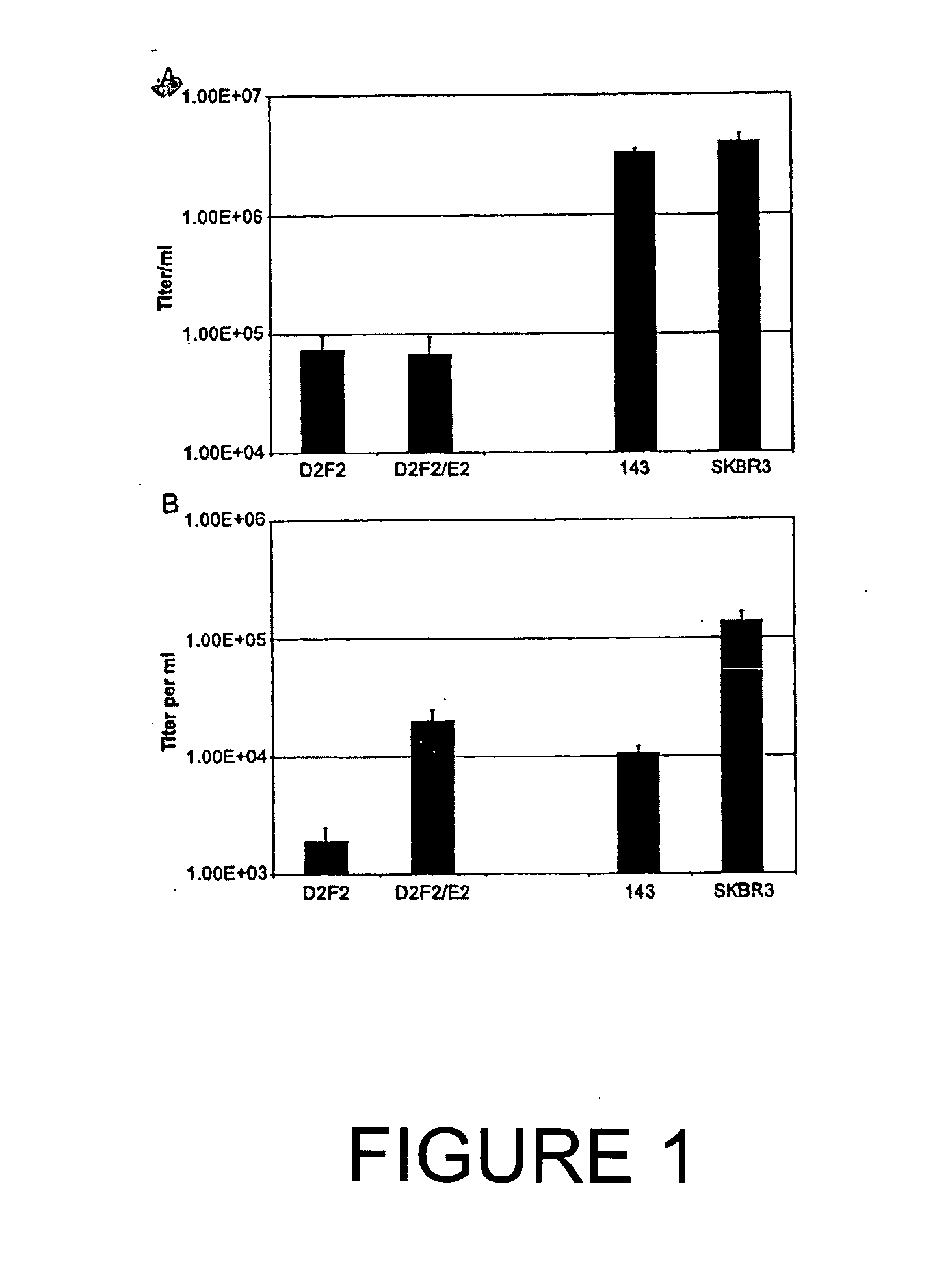Targeting viruses using a modified sindbis glycoprotein
a technology of sindbis and glycoprotein, which is applied in the direction of peptide sources, dsdna viruses, fusions for specific cell targeting, etc., can solve the problems of insufficient treatment for metastatic breast cancer, inability to consistently improve the survival rate of patients with metastatic disease, and often fatal disease of metastatic breast cancer. achieve the effect of improving the expression of a modified glycoprotein and improving the infectivity
- Summary
- Abstract
- Description
- Claims
- Application Information
AI Technical Summary
Benefits of technology
Problems solved by technology
Method used
Image
Examples
example 1
Materials
[0063] Cells, antibodies and chemicals. The following cell lines were obtained from American Type Culture Collection (ATCC) (Rockville, Md.) and grown using standard tissue culture techniques in a humidified incubator at 37 8C with 5% CO2: SKBR3 human breast adenocarcinoma, 143 human osteosarcoma, COS-7 simian kidney and BHK 21 hamster kidney. SKBR3 cells are known Her2 / neu amplified / over-expressing breast cancer cells whereas 143 do not express measurable Her2 / neu (Bergman et al., 2001). D2F2 / E2 is a mouse mammary tumor line that has been stably transfected with a vector expressing the human Her2 / neu gene and was a obtained from Dr. Wei-Zen Wei, Karmanos Cancer Institute, Wayne State University, Detroit, Mich. D2F2 is the parent mouse mammary tumor cell line. Absence of mycoplasma contamination in all cell lines was confirmed by the Gen-Probe rapid detection system (Gen-Probe Incorp., San Diego, Calif.). MAb 4D5, a mouse monoclonal antibody directed to the Her2 / neu recept...
example 2
Creation of Vector Expressing Sindbis gp Mutations (Sindbis-SCA)
[0064] This example discloses the steps for generating a vector expressing a modified Sindbis gp with amino acids 72 and 73 deleted and an SCA with linkers on each side placed in this site.
[0065] PCR as detailed below was performed to create the following construct called PCR product #1: BstEIl-Glycine linker-Nhe 1-Single chain antibody (SCA)-Cla1-Spacer-BstEIl. Preceding the mature SCA, between the BstEII and Nhe1 restriction sites, a flexible poly-glycine linker was inserted. Following the mature SCA between the Cla1 and BstEII restriction sites, a spacer adapted from Jost et al. (1996) was inserted and consisting of the first 13 amino acids of the CH1 region of the 2C11 hamster monoclonal antibody and a flexible serine-glycine end. This construct was used to replace ZZ between amino acids 71 and 74 of the Sindbis-ZZ chimeric gp to create a chimeric Sindbis gp which consisted of the first 71 amino acids of E2 follow...
example 3
Creation of Vector Comprising EGFP (MCS-EGFP-δG / XN2)
[0070] The VSV-G gene was removed from the VSV genome and replaced it with the gene for enhanced green fluorescent protein(EGFP) and a multiple cloning site (MCS). The PCR protocol as detailed below was followed to create the following construct called PCR product #2: Mlu 1-MCS-Stop-Start-EG FP-Stop-Start-Nhe 1
[0071] The EGFP gene was amplified using PCR from vector EGFRPN-1 (Clontech, Palo Alto, Calif.) using the following primers to add a multiple cloning site containing Not 1 and Pme 1 restriction sites and VSV transcription stop and start signals (italics) in front of the gene for EGFP:
Forward primer:(SEQ ID NO:3)gcgACGCGT cgtacggtaacctcgagaaagcggccgcgcgcgtttaaactatgaaaaaaactaacagagatccactatggtgagcaagggcgaReverse primer:(SEQ ID NO:4)gcgGCT AGCcgtgatatctgttagtttttttcatactgagttacttgtacagctcgtcc
[0072] The PCR product was ligated into a cloning vector, bacteria was transformed, clonal DNA was isolated and digested with Mlu1 and...
PUM
| Property | Measurement | Unit |
|---|---|---|
| temperature | aaaaa | aaaaa |
| pH | aaaaa | aaaaa |
| pH | aaaaa | aaaaa |
Abstract
Description
Claims
Application Information
 Login to View More
Login to View More - R&D
- Intellectual Property
- Life Sciences
- Materials
- Tech Scout
- Unparalleled Data Quality
- Higher Quality Content
- 60% Fewer Hallucinations
Browse by: Latest US Patents, China's latest patents, Technical Efficacy Thesaurus, Application Domain, Technology Topic, Popular Technical Reports.
© 2025 PatSnap. All rights reserved.Legal|Privacy policy|Modern Slavery Act Transparency Statement|Sitemap|About US| Contact US: help@patsnap.com



